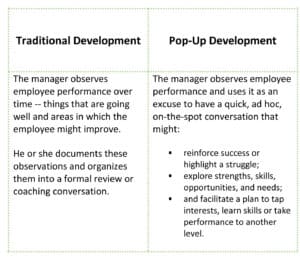Have you noticed the recent trend toward “pop-up” establishments? Over the holidays, I shopped in pop-up stores and ate in pop-up restaurants, and so did many other people. It’s a phenomenon in which retailers, chefs or other entrepreneurs temporarily take over a space to operate their businesses. They’re only there for one night or perhaps a whole season, and then they move on.
 Pop-ups are an ideal way to take advantage of a market or customer base and to seize a promising prospect quickly. Pop-ups are nimble — able to adjust and respond to changing conditions. They don’t rely upon fixed spaces but rather go where the opportunities present themselves. And they’re fundamentally quicker to market, without protracted lead-times.
Pop-ups are an ideal way to take advantage of a market or customer base and to seize a promising prospect quickly. Pop-ups are nimble — able to adjust and respond to changing conditions. They don’t rely upon fixed spaces but rather go where the opportunities present themselves. And they’re fundamentally quicker to market, without protracted lead-times.
What if we applied a pop-up mentality to employee development?
Too frequently, development is treated like the businesses in which it operates. Managers have fixed times and places where coaching and mentoring occur. Individual development-planning sessions and performance reviews are scheduled for the same time each year. Development conversations are relegated to formal spaces like offices and conference rooms.
As a result, employee development lacks the nimbleness, fluidity and responsiveness required to drive learning, growth and results in today’s fast-moving business climate. Our traditional, formal and fixed approach to employee development would benefit from a pop-up makeover.
Pop-up developers are spontaneous and iterative — just like the businesses that have adopted this approach. And they’re adept at a few key skills that differentiate them from traditional developers. Pop-up developers:
- Ask good questions. Pop-up developers are facilitative. They share their observations then quickly engage the employee in conversation through the use of questions that promote reflection, insight and ownership. The quality of these conversations does not rely upon long lead-time planning and preparation, but rather upon leaders who are genuinely curious about and interested in others — and who manifest it with great questions.
- Collaboratively solve problems. Pop-up developers recognize opportunities for improvement as a chance to partner with employees to jointly understand the issues and generate strategies for addressing them. (And in the process, they build an unbeatable foundation of trust.) These leaders are proactive. They recognize the beginnings of performance or behavioral trends and jump on the chance to work together to address them.
- Inspire optimism. Pop-up developers see possibilities in all of their employees. They believe that everyone has the ability to learn and improve, including those who are performing well. And this sense of confidence infects employees with a feeling of hope and challenges everyone to enhance their abilities and contributions.
- Instill accountability. Pop-up developers leave ownership for development where it belongs — with the employee. They know that people are most likely to implement plans they’ve created; so they support employees in identifying and monitoring their own next steps and actions.
Traditional establishments will likely always have a place in our economy. But it just might be time for traditional employee development to give way to a less staid and more flexible system. Perhaps a pop-up approach will better propel people and performance forward!
Image: (c) Can Stock Photo / trucic



greatidea Julie…..certainly fits the idea of more “touch points” not only in CD but in Perf. Mgt too…..creative imagery with the pop up idea……thanks.
I like the imagery too. This approach requires a really stable and solid leader. Are there enough of those to do this effectively?
I like the approach. This approach requires very stable and seasoned leaders who are sure of what they want to see and generous to team members. Are there enough of those available to successfully implement this approach?
Thanks, Jenny! I agree that this approach requires a generosity of spirit, genuine curiosity, and attention to the needs of others. As for the number of these types of folks out there… that’s hard to quantify. I’ve certainly crossed paths with many… and these folks have a way of inspiring others. How is this type of leadership built/supported in your organizaiton?
An excellent article. As an L&D Manager, I have been trying to get managers to understand their personal role in continuous staff development for a long time. The “pop-up” phrase may be helpful in this. How to make the most of arising opportunities and enable embedded learning because it occurs outside of the training room is critical. This is a strong mechanism for adults to learn as contextualising supports increased understanding and memory for most employees. Bernie Gibbins
Great point, Bernie. The contextualization is key… as is the confidence that’s built as a result of sorting/trying things out real-time with a little support. Thanks so much for sharing… and good luck as you continue to help leaders help others to grow!
I like the imagery too. This approach requires a really stable and solid leader. Are there enough of those to do this effectively?
I couldn’t agree more. The success of this kind of in-the-moment develop rests with skillful leaders. I know so many who can pull it off with just a little support. But, developing more of them can only be a good thing… right? Thanks for sharing your thoughts!